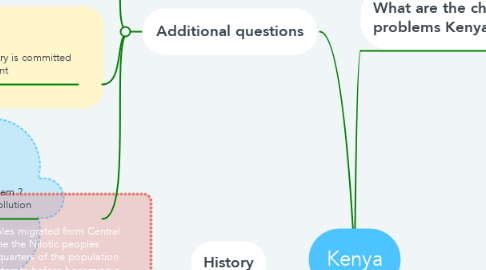Kenya
by Robin DEVOUCOUX

1. Additional questions
1.1. What are the environmental health issues ? The environmental health issue has to manage and substance her environment and natural resources base they want to depend on agriculture and agro based industries (tourism, water resource and hydropower)
1.2. Is Kenya is sustainable ? Yes it is because the country is committed to protecting its environnent
1.3. What is Kenya’s biggest problem ? The biggest problem water pollution
2. History
2.1. At the end of the first millennium Bantu peoples migrated from Central Africa to the region. From 1500 after J.C came the Nilotic peoples from Sudan. These peoples now form three-quarters of the population of Kenya. Kenya was briefly a German protectorate before becoming a British protectorate and then an English colony in 1890. The country has been independent since December 12, 1963
3. Geography and climate
3.1. Kenya is in the centre of side of west of Africa. The climate is equatorial
4. Economy
4.1. There are 4 main areas of economic activity - Agriculture (35% GDP) - Tourism (47.7% GDP) - Industry (agro based) / 17.7 % GDP) - Exploitation of natural resources (water resources and hydropower / 1% GDP) Kenya is the 7th richest country in Africa (GDP in 2019)
5. What are the challenges / problems Kenya has to meet ?
5.1. climate variability and food insecurity (water scarcity),
5.2. wildlife trafficking and crime,
5.3. Urban expansion, deforestation (loss of Biodiversity), soil erosion and desertification (ecosystem damage and devast the agriculture sector),
5.4. Rapid population growth.
6. How is Kenya involved in preserving its future ?
6.1. Biodiversity Conservation : Communities play a key role in both the protection and conservation of wildlife.
6.2. Clean Energy and Climate Change Adaptation : Kenya adopt a development program named “Vision 2030” to transform the economy of the country. The government want to find solution for the management of water (waste water and water treatment), the waste (reduction and collect) and reduce the pollution. This decision focus “0 waste” up to 2030 and access to drinking water for all the population. For example since July 2017 the plastics bags are not allowed in the country.
6.3. Counter Wildlife Trafficking : Government to explore innovative ways to protect animals (Save the Elephants) to counter wildlife trafficking and prosecute wildlife crimes.
6.4. Increasing food security : The initiative shares modern farming practices. They focus on four main value chains: dairy, livestock, horticulture, and staple foods. We also link farmers to markets, improve seed quality, increase access to financing, and promote private sector solutions.
7. Wildlife
7.1. Kenya’s geographic diversity means that it supports an extraordinary range of wildlife. The country’s premier national parks and reserves, a list that includes the Masai Mara, Amboseli, Tsavo East and West, Samburu-Buffalo Springs, Meru and Laikipia, are all home to most or all of the Big Five, i.e. lion, leopard, elephant, buffalo and Black rhino.


